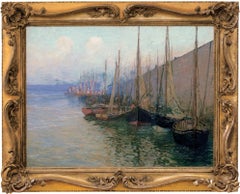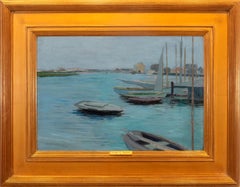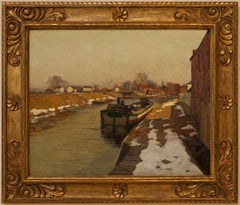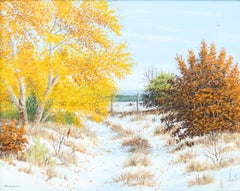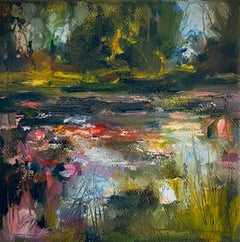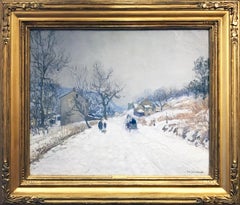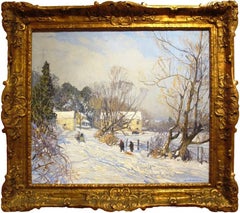Edward Willis Redfield Art
to
1
2
Overall Width
to
Overall Height
to
1
2
2
3
3
3
1
1
3
3
3
3
3
9,514
2,694
1,375
1,361
3
3
Artist: Edward Willis Redfield
"In Port"
By Edward Willis Redfield
Located in Lambertville, NJ
Jim’s of Lambertville is proud to offer this artwork by:
Edward Willis Redfield (1869 - 1965)
Edward W. Redfield was born in Bridgeville, Delaware, moving to Philadelphia as a young child. Determined to be an artist from an early age, he studied at the Spring Garden Institute and the Franklin Institute before entering the Pennsylvania Academy from 1887 to 1889, where he studied under Thomas Anshutz, James Kelly, and Thomas Hovenden. Along with his friend and fellow artist, Robert Henri, he traveled abroad in 1889 and studied at the Academie Julian in Paris under William Bouguereau and Tony Robert-Fleury. While in France, Redfield met Elise Deligant, the daughter of an innkeeper, and married in London in 1893.
Upon his return to the United States, Redfield and his wife settled in Glenside, Pennsylvania. He remained there until 1898, at which time he moved his family to Center Bridge, a town several miles north of New Hope along the Delaware River. Redfield painted prolifically in the 1890s but it was not until the beginning of the twentieth century that he would develop the bold impressionist style that defined his career. As Redfield’s international reputation spread, many young artists gravitated to New Hope as he was a great inspiration and an iconic role model. Edward Redfield remained in Center Bridge throughout his long life, fathering his six children there.
Around 1905 and 1906, Redfield’s style was coming into its own, employing thick vigorous brush strokes tightly woven and layered with a multitude of colors. These large plein-air canvases define the essence of Pennsylvania Impressionism. By 1907, Redfield had perfected his craft and, from this point forward, was creating some of his finest work.
Redfield would once again return to France where he painted a small but important body of work between 1907 and 1908. While there, he received an Honorable Mention from the Paris Salon for one of these canvases. In 1910 he was awarded a Gold Medal at the prestigious Buenos Aires Exposition and at the Panama-Pacific Exposition of 1915 in San Francisco, an entire gallery was dedicated for twenty-one of his paintings.
Since Redfield painted for Exhibition with the intent to win medals, his best effort often went into his larger paintings. Although he also painted many fine smaller pictures, virtually all of his works were of major award-winning canvas sizes of 38x50 or 50x56 inches. If one were to assign a period of Redfield’s work that was representative of his “best period”, it would have to be from 1907 to 1925. Although he was capable of creating masterpieces though the late 1940s, his style fully matured by 1907 and most work from then through the early twenties was of consistently high quality. In the later 1920s and through the 1930s and 1940s, he was like most other great artists, creating some paintings that were superb examples and others that were of more ordinary quality.
Redfield earned an international reputation at a young age, known for accurately recording nature with his canvases and painting virtually all of his work outdoors; Redfield was one of a rare breed. He was regarded as the pioneer of impressionist winter landscape painting in America, having few if any equals. Redfield spent summers in Maine, first at Boothbay Harbor and beginning in the 1920s, on Monhegan Island. There he painted colorful marine and coastal scenes as well as the island’s landscape and fishing shacks. He remained active painting and making Windsor style furniture...
Category
Early 1900s American Impressionist Edward Willis Redfield Art
Materials
Canvas, Oil
"Sail Boats in Harbor"
By Edward Willis Redfield
Located in Lambertville, NJ
Jim’s of Lambertville is proud to offer this artwork by:
Edward Willis Redfield (1869 - 1965)
Edward W. Redfield was born in Bridgeville, Delaware, moving to Philadelphia as a youn...
Category
1890s American Impressionist Edward Willis Redfield Art
Materials
Canvas, Oil
"The Canal"
By Edward Willis Redfield
Located in Lambertville, NJ
Jim’s of Lambertville is proud to offer this artwork.
Signed lower left. Complemented by a hand carved and gilt frame.
Illustrated in "Edward Redfield: Just Values and Fine Seeing" by Constance Kimmerle and the Pennsylvania Academy of the Fine Arts's Exhibition of Paintings by Edward Redfield (April 17 to May 16, 1909) brochure
Edward Willis Redfield (1869 - 1965)
Edward W. Redfield was born in Bridgeville, Delaware, moving to Philadelphia as a young child. Determined to be an artist from an early age, he studied at the Spring Garden Institute and the Franklin Institute before entering the Pennsylvania Academy from 1887 to 1889, where he studied under Thomas Anshutz, James Kelly, and Thomas Hovenden. Along with his friend and fellow artist, Robert Henri, he traveled abroad in 1889 and studied at the Academie Julian in Paris under William Bouguereau and Tony Robert-Fleury. While in France, Redfield met Elise Deligant, the daughter of an innkeeper, and married in London in 1893.
Upon his return to the United States, Redfield and his wife settled in Glenside, Pennsylvania. He remained there until 1898, at which time he moved his family to Center Bridge, a town several miles north of New Hope along the Delaware River. Redfield painted prolifically in the 1890s but it was not until the beginning of the twentieth century that he would develop the bold impressionist style that defined his career. As Redfield’s international reputation spread, many young artists gravitated to New Hope as he was a great inspiration and an iconic role model. Edward Redfield remained in Center Bridge throughout his long life, fathering his six children there.
Around 1905 and 1906, Redfield’s style was coming into its own, employing thick vigorous brush strokes tightly woven and layered with a multitude of colors. These large plein-air canvases define the essence of Pennsylvania Impressionism. By 1907, Redfield had perfected his craft and, from this point forward, was creating some of his finest work.
Redfield would once again return to France where he painted a small but important body of work between 1907 and 1908. While there, he received an Honorable Mention from the Paris Salon for one of these canvases. In 1910 he was awarded a Gold Medal at the prestigious Buenos Aires Exposition and at the Panama-Pacific Exposition of 1915 in San Francisco, an entire gallery was dedicated for twenty-one of his paintings.
Since Redfield painted for Exhibition with the intent to win medals, his best effort often went into his larger paintings. Although he also painted many fine smaller pictures, virtually all of his works were of major award-winning canvas sizes of 38x50 or 50x56 inches. If one were to assign a period of Redfield’s work that was representative of his “best period”, it would have to be from 1907 to 1925. Although he was capable of creating masterpieces though the late 1940s, his style fully matured by 1907 and most work from then through the early twenties was of consistently high quality. In the later 1920s and through the 1930s and 1940s, he was like most other great artists, creating some paintings that were superb examples and others that were of more ordinary quality.
Redfield earned an international reputation at a young age, known for accurately recording nature with his canvases and painting virtually all of his work outdoors; Redfield was one of a rare breed. He was regarded as the pioneer of impressionist winter landscape painting in America, having few if any equals. Redfield spent summers in Maine, first at Boothbay Harbor and beginning in the 1920s, on Monhegan Island. There he painted colorful marine and coastal scenes as well as the island’s landscape and fishing shacks. He remained active painting and making Windsor style furniture...
Category
Early 1900s American Impressionist Edward Willis Redfield Art
Materials
Canvas, Oil
Related Items
Snowy Landscape w Cardinal
By Manuel Garza
Located in Austin, TX
"Snowy Landscape w Cardinal" by Manuel Garza
Oil on Canvas
16 x 20 inches
Framed size 24 x 28"
A serene, naturalistic rendition of a forested Texas l...
Category
Late 20th Century American Impressionist Edward Willis Redfield Art
Materials
Canvas, Oil
"Le Jardin de Monet, II" (2023) by Leigh Ann Van Fossan, Oil Painting, Lily Pond
By Leigh Ann Van Fossan
Located in Denver, CO
Leigh Ann Van Fossan's "Le Jardin de Monet, II" is an original, handmade oil painting that depicts an impression of a lily pond.
Van Fossan was born in Vail, Colorado, and began oi...
Category
2010s American Impressionist Edward Willis Redfield Art
Materials
Canvas, Oil
"Cove" Oil Painting
By Leigh Ann Van Fossan
Located in Denver, CO
Leigh Ann Van Fossan's "Cove" is an original, handmade oil painting that depicts bright teal colored cove where water meets the shore and the atmospheric pastel sky reflects in the b...
Category
2010s American Impressionist Edward Willis Redfield Art
Materials
Oil, Canvas
A Western Mountain Scene
Located in San Francisco, CA
Snow-topped jagged peaks reflected in a mountain lake come together in this ethereal landscape painting by noted American artist Courtney Luther Miles (1887-1975). Self-taught and ac...
Category
Mid-20th Century American Impressionist Edward Willis Redfield Art
Materials
Canvas, Oil
“Sailboats on the Shore”
Located in San Francisco, CA
We might share with you the biography of Texas-born Steven Seymour Thomas (1868-1956), but it would take pages. Consider his precocious talent, which catapulted him to fame in New Yo...
Category
Late 19th Century American Impressionist Edward Willis Redfield Art
Materials
Canvas, Oil
"The Inlet" Oil Painting
By Leigh Ann Van Fossan
Located in Denver, CO
Leigh Ann Van Fossan's "The Inlet" is an original, handmade oil painting that depicts a group of sailboats docked in the darkness as their lights cast glimmering reflections on the i...
Category
2010s American Impressionist Edward Willis Redfield Art
Materials
Canvas, Oil
Seascape at Naples Beach, Florida- Coastal Landscape Oil Painting in Gold Frame
By Emile Gruppe
Located in Marco Island, FL
Gorgeous original oil painting of Naples Beach, Florida by renowned American artist Emile Gruppe. The perspective of the painting allows the viewer to travel past the native palm t...
Category
Mid-20th Century American Impressionist Edward Willis Redfield Art
Materials
Canvas, Oil
$14,000
H 27.5 in W 31.5 in D 4 in
Mystic River Valley
By Edward Herbert Barnard
Located in New York, NY
Signed lower left: EH Barnard
Category
19th Century American Impressionist Edward Willis Redfield Art
Materials
Canvas, Oil
Brian Blood 'Monterey Bay' Plein Air California Impressionist Seascape Painting
By Brian Blood
Located in San Rafael, CA
Brian Blood (American, b. 1962)
Monterey Bay, 2000
Oil on canvas board
Signed lower right: BB signed, dated, and titled verso: Brian Blood, 2000 Monterey Bay
9in H x 12in L
In a silvered gilt frame with linen mat and moulding: 17 1/4in H x 20in L
Brian Blood is a resident of Pebble Beach, California. He began his professional life as a graphic artist and art director in Boston, Massachusetts. He then came to California to attend the Academy of Art College in San Francisco for both undergraduate and graduate studies. In 2003, Blood and his artist wife, Laurie Kersey...
Category
Early 2000s American Impressionist Edward Willis Redfield Art
Materials
Canvas, Oil
$2,500
H 17.5 in W 20 in D 2.5 in
"Texas Pastoral Bluebonnet Scene" Framed Oil Painting Spring Wildflowers Farm
By Dalhart Windberg
Located in Austin, TX
Canvas size: 9 x 12 in.
Frame size: 17 x 19.5 in.
Signed, bottom left in red "Windberg"
A serene, nostalgic scene that captures a Central Texas pastoral landscape with a soft, impre...
Category
1970s American Impressionist Edward Willis Redfield Art
Materials
Canvas, Oil
"Place de Abbesses" Naturalistic Painting City Paris Street Montmarte in Spring
By Manfred Rapp
Located in Austin, TX
Oil on Canvas
canvas size: 8 x 10 in.
frame size: 13 x 15 in.
"Place de Abbesses" is a illustrative, plein air, city street scene featuring historic Montmarte, a Paris neighborhood ...
Category
Late 20th Century American Impressionist Edward Willis Redfield Art
Materials
Canvas, Oil
"Looking For Respite" (2008) By Jennifer McChristian, Original Oil Painting
Located in Denver, CO
Jennifer McChristian's "Looking For Respite" (2008) is an original, handmade oil painting that depicts a busy sidewalk with people walking and bus...
Category
2010s American Impressionist Edward Willis Redfield Art
Materials
Canvas, Oil, Panel
Previously Available Items
Road to New Hope
By Edward Willis Redfield
Located in Lambertville, NJ
Ashley John is proud to offer this artwork by:
Edward Willis Redfield (1869 - 1965)
Edward W. Redfield was born in Bridgeville, Delaware, moving to Philadelphia as a young child. D...
Category
20th Century American Impressionist Edward Willis Redfield Art
Materials
Canvas, Oil
"The Road to the Mill"
By Edward Willis Redfield
Located in Lambertville, NJ
Signed lower right. Complemented by animi original period Newcomb Macklin frame.
Edward Willis Redfield (1869 - 1965)
Edward W. Redfield was born in Bridgeville, Delaware, moving...
Category
1920s American Impressionist Edward Willis Redfield Art
Materials
Canvas, Oil
"88 Club"
By Edward Willis Redfield
Located in Lambertville, NJ
Signed and titled lower center.
Complemented by a hand carved and gilt frame.
Edward Willis Redfield (1869 - 1965)
Edward W. Redfield was born in Bridgeville, Delaware, moving to Philadelphia as a young child. Determined to be an artist from an early age, he studied at the Spring Garden Institute and the Franklin Institute before entering the Pennsylvania Academy from 1887 to 1889, where he studied under Thomas Anshutz, James Kelly, and Thomas Hovenden. Along with his friend and fellow artist, Robert Henri, he traveled abroad in 1889 and studied at the Academie Julian in Paris under William Bouguereau and Tony Robert-Fleury. While in France, Redfield met Elise Deligant, the daughter of an innkeeper, and married in London in 1893.
Upon his return to the United States, Redfield and his wife settled in Glenside, Pennsylvania. He remained there until 1898, at which time he moved his family to Center Bridge, a town several miles north of New Hope along the Delaware River. Redfield painted prolifically in the 1890s but it was not until the beginning of the twentieth century that he would develop the bold impressionist style that defined his career. As Redfield’s international reputation spread, many young artists gravitated to New Hope as he was a great inspiration and an iconic role model. Edward Redfield remained in Center Bridge throughout his long life, fathering his six children there.
Around 1905 and 1906, Redfield’s style was coming into its own, employing thick vigorous brush strokes tightly woven and layered with a multitude of colors. These large plein-air canvases define the essence of Pennsylvania Impressionism. By 1907, Redfield had perfected his craft and, from this point forward, was creating some of his finest work.
Redfield would once again return to France where he painted a small but important body of work between 1907 and 1908. While there, he received an Honorable Mention from the Paris Salon for one of these canvases. In 1910 he was awarded a Gold Medal at the prestigious Buenos Aires Exposition and at the Panama-Pacific Exposition of 1915 in San Francisco, an entire gallery was dedicated for twenty-one of his paintings.
Since Redfield painted for Exhibition with the intent to win medals, his best effort often went into his larger paintings. Although he also painted many fine smaller pictures, virtually all of his works were of major award-winning canvas sizes of 38x50 or 50x56 inches. If one were to assign a period of Redfield’s work that was representative of his “best period”, it would have to be from 1907 to 1925. Although he was capable of creating masterpieces though the late 1940s, his style fully matured by 1907 and most work from then through the early twenties was of consistently high quality. In the later 1920s and through the 1930s and 1940s, he was like most other great artists, creating some paintings that were superb examples and others that were of more ordinary quality.
Redfield earned an international reputation at a young age, known for accurately recording nature with his canvases and painting virtually all of his work outdoors; Redfield was one of a rare breed. He was regarded as the pioneer of impressionist winter landscape painting in America, having few if any equals. Redfield spent summers in Maine, first at Boothbay Harbor and beginning in the 1920s, on Monhegan Island. There he painted colorful marine and coastal scenes as well as the island’s landscape and fishing shacks. He remained active painting and making Windsor style furniture...
Category
1950s American Impressionist Edward Willis Redfield Art
Materials
Paper, Ink
"Fisherman Beach, Monhegan"
By Edward Willis Redfield
Located in Lambertville, NJ
Signed and dated lower right.
Complemented by a hand carved and gilt frame.
Edward Willis Redfield (1869 - 1965)
Edward W. Redfield was born in Bridgeville, Delaware, moving to Philadelphia as a young child. Determined to be an artist from an early age, he studied at the Spring Garden Institute and the Franklin Institute before entering the Pennsylvania Academy from 1887 to 1889, where he studied under Thomas Anshutz, James Kelly, and Thomas Hovenden. Along with his friend and fellow artist, Robert Henri, he traveled abroad in 1889 and studied at the Academie Julian in Paris under William Bouguereau and Tony Robert-Fleury. While in France, Redfield met Elise Deligant, the daughter of an innkeeper, and married in London in 1893.
Upon his return to the United States, Redfield and his wife settled in Glenside, Pennsylvania. He remained there until 1898, at which time he moved his family to Center Bridge, a town several miles north of New Hope along the Delaware River. Redfield painted prolifically in the 1890s but it was not until the beginning of the twentieth century that he would develop the bold impressionist style that defined his career. As Redfield’s international reputation spread, many young artists gravitated to New Hope as he was a great inspiration and an iconic role model. Edward Redfield remained in Center Bridge throughout his long life, fathering his six children there.
Around 1905 and 1906, Redfield’s style was coming into its own, employing thick vigorous brush strokes tightly woven and layered with a multitude of colors. These large plein-air canvases define the essence of Pennsylvania Impressionism. By 1907, Redfield had perfected his craft and, from this point forward, was creating some of his finest work.
Redfield would once again return to France where he painted a small but important body of work between 1907 and 1908. While there, he received an Honorable Mention from the Paris Salon for one of these canvases. In 1910 he was awarded a Gold Medal at the prestigious Buenos Aires Exposition and at the Panama-Pacific Exposition of 1915 in San Francisco, an entire gallery was dedicated for twenty-one of his paintings.
Since Redfield painted for Exhibition with the intent to win medals, his best effort often went into his larger paintings. Although he also painted many fine smaller pictures, virtually all of his works were of major award-winning canvas sizes of 38x50 or 50x56 inches. If one were to assign a period of Redfield’s work that was representative of his “best period”, it would have to be from 1907 to 1925. Although he was capable of creating masterpieces though the late 1940s, his style fully matured by 1907 and most work from then through the early twenties was of consistently high quality. In the later 1920s and through the 1930s and 1940s, he was like most other great artists, creating some paintings that were superb examples and others that were of more ordinary quality.
Redfield earned an international reputation at a young age, known for accurately recording nature with his canvases and painting virtually all of his work outdoors; Redfield was one of a rare breed. He was regarded as the pioneer of impressionist winter landscape painting in America, having few if any equals. Redfield spent summers in Maine, first at Boothbay Harbor and beginning in the 1920s, on Monhegan Island. There he painted colorful marine and coastal scenes as well as the island’s landscape and fishing shacks. He remained active painting and making Windsor style furniture...
Category
1920s American Impressionist Edward Willis Redfield Art
Materials
Canvas, Oil
"Winter Sports"
By Edward Willis Redfield
Located in Lambertville, NJ
Signed Lower Left
Period Newcomb Macklin Frame
Edward W. Redfield was born in Bridgeville, Delaware, moving to Philadelphia as a young child. Determined to be an artist from a...
Category
20th Century American Impressionist Edward Willis Redfield Art
Materials
Canvas, Oil
Lumberville
By Edward Willis Redfield
Located in Lambertville, NJ
Winter village sleigh Landscape town snow
Category
20th Century Edward Willis Redfield Art
Materials
Oil, Canvas
Early Morning Sunlight, Spring
By Edward Willis Redfield
Located in Lambertville, NJ
Category
20th Century Edward Willis Redfield Art
Materials
Oil, Canvas
Edward Willis Redfield art for sale on 1stDibs.
Find a wide variety of authentic Edward Willis Redfield art available for sale on 1stDibs. You can also browse by medium to find art by Edward Willis Redfield in canvas, fabric, oil paint and more. Much of the original work by this artist or collective was created during the early 1900s and is mostly associated with the Impressionist style. Not every interior allows for large Edward Willis Redfield art, so small editions measuring 37 inches across are available. Customers who are interested in this artist might also find the work of Edward Henry Potthast, Irving Ramsey Wiles, and Henry Bacon. Edward Willis Redfield art prices can differ depending upon medium, time period and other attributes. On 1stDibs, the price for these items starts at $61,875 and tops out at $781,250, while the average work can sell for $531,250.
